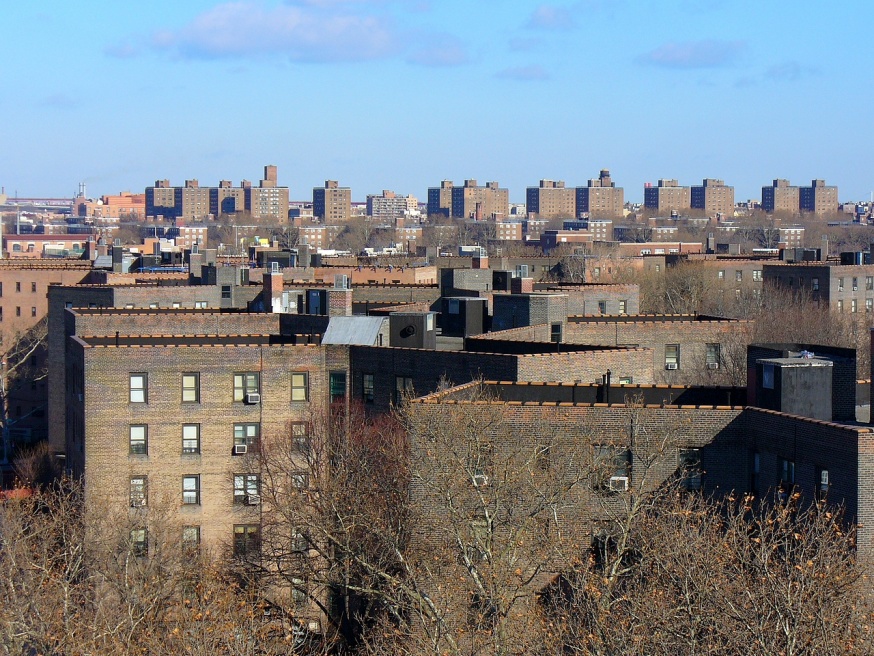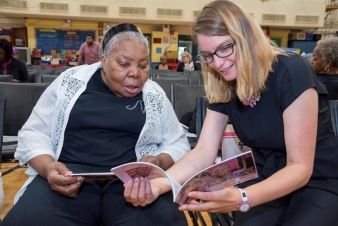
Queensbridge Houses (Photo: Wikimedia Commons via Metro Centric CC BY 2.0)
Oct. 17, 2019 By Allie Griffin
A new book was released earlier this month on the history of the Queensbridge Houses, the country’s largest public housing complex located in Long Island City.
Voices of Queensbridge: Stories from the Nation’s Largest Public Housing Development, published by LaGuardia Community College and Wagner Archives, explores the history of Queensbridge and the lives of people who call it home.
The book provides a timeline and history of the Queensbridge Houses, including summaries of its origins, demographic changes, crime levels, community and gentrification’s impact.
Queensbridge Houses has 3,142 apartments and nearly 7,000 residents, making it the largest public housing development in North America.
The development opened in 1939 next to the Queensboro Bridge along the East River in what was at the time a largely manufacturing area. Its construction began a year earlier in 1938 after Mayor Fiorello LaGuardia launched the New York City Housing Authority (NYCHA) four years earlier.
The book also illustrates the development’s history through first-person accounts from the people who know it best, its tenants. Students at LaGuardia Community College interviewed 18 long-time senior residents on topics like family history, crime and safety, police relations, maintenance, gentrification, demographic change and race, tenant activism, community and the senior center.
The publication was celebrated at a recent gathering that included LaGuardia faculty, Queensbridge Houses residents and representatives of the nonprofit Jacob A Riis Neighborhood Settlement, which has a senior center for residents.
“This project is about what it means to be a New Yorker. It’s about expanding and strengthening our community,” said Molly Rosner, Ph.D., assistant director of education programs for Wagner Archives, who co-edited the book. “The students learned to connect with neighbors because that’s what makes a city feel like home.”

Queensbridge resident Nellie Pettway (right) with LaGuardia and Wagner Archives’ Molly Rosner (Photo: LaGuardia Community College)
The students who collected residents’ oral histories came from a variety of backgrounds. Some had lived in public housing themselves, while others had no prior experience with it. They began the oral history project in fall 2018 and through it, they connected with residents.
“This project challenges the preconceived notions of public housing and the people who live there,” said student and interviewer Amanda Jones in a statement.
“My fellow students and I didn’t just watch and listen to the residents of Queensbridge, we interacted with them, and in doing so, realized that despite having different backgrounds, we share many commonalities. We related to one each other’s struggles.”
Voices of Queensbridge is available to view and download for free on the LaGuardia and Wagner Archives shared website.
8 Comments

Looking at the comments of some of the people above they appear to be so out of touch, most people in public housing work, what you see around the complex are people that don’t live there, they are from the shelters in the neighborhood, there is crime and undesirables everywhere. You have everything else in the neighborhood let us live, were not coming to you you are coming to us and pushing us out of our neighborhood, the cars you see are from people who park in the neighborhood and get on the subway, not from the residents. Be happy where you are, and stop putting people down because you don’t know there situation until it’s at your door, why did you move to the neighborhood if you opposed the people in it.
Nycha was meant for returning veterans and families to get back on they’re feet. Not freeload and have three generations living there. Wonderful to residents with range rovers bmw’s and MB s class cars parked in the spots
So let me understand this. Western queens has the largest affordable housing program in the USA. And the 3 fools , ocasio-cortex/gianiris/van bramer dont want market rate apartments or good paying jobs in western queens. Gosh, i cant wait until the election next year to vote those 3 idiots out of office. they have done tremendous harm to our borough.
How come nobody complains about the lack of diversity in these projects?
How woke, waxing nostalgic about the projects.
You should find people who lived there in the 50s and 60s when Queensbridge was beautiful. I loved going there to play in the play areas between the buildings. I know many people who lived there at that time and they came from different backgrounds and respected the place where they lived. The complex was a place for people to use as a steppingstone to improve economically and then move on. It was never meant to be permanent housing for decades. It was meant to help economically challenged families improve their financial situations and then move on. They were meant to be a steppingstone to a better life.
Public housing has become an economic drain on the city. Today it’s not what it was intended to be.
Vertical ghetto, biggest problem is the residents.
Nice way to smear 7,000 people. Just as many criminals living in the Hunters Point towers, but they’re all wearing white collars.